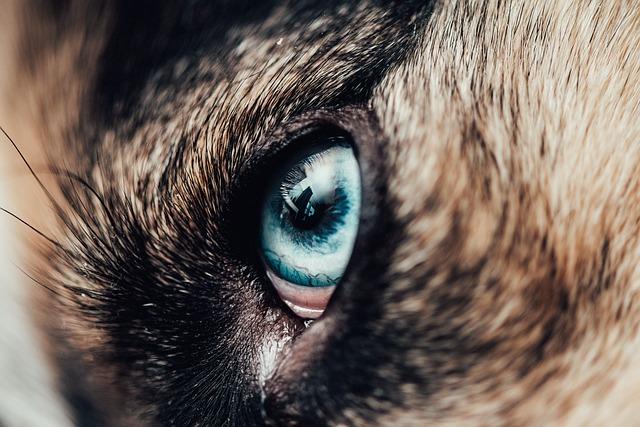In the world of dog training, where trust and communication lay the foundation for a strong bond, eye contact emerges as an essential tool often overlooked by pet owners. Imagine a connection so profound that a simple glance conveys understanding and intent between you and your furry companion. Eye contact is not just about getting your dog’s attention; it’s a fundamental aspect of building mutual respect and enhancing the learning experience. In this article, we will explore why maintaining eye contact is crucial in dog training, how it can transform your interactions, and provide practical tips to harness this powerful yet subtle form of communication. Whether you’re a seasoned trainer or a first-time pet parent, understanding the role of eye contact can lead to more effective training sessions and a deeper relationship with your dog.
Understanding Canine Communication: The Role of Eye Contact
Eye contact is a powerful tool in dog training, serving as a bridge for communication between humans and their canine companions. Dogs are highly attuned to the subtleties of human expressions, and maintaining eye contact can reinforce the bond of trust and understanding. When you lock eyes with your dog, you’re not just capturing their attention; you’re engaging in a silent conversation that conveys your intentions, emotions, and commands. Dogs interpret eye contact as a sign of confidence and leadership, which can significantly enhance their responsiveness to training cues.
- Builds Trust: Consistent eye contact helps establish a foundation of trust, making your dog feel more secure and connected.
- Improves Focus: Eye contact encourages your dog to focus on you, reducing distractions and improving the effectiveness of training sessions.
- Enhances Communication: Through eye contact, dogs can better understand your mood and intentions, allowing for more nuanced interactions.
Incorporating eye contact into your training routine can be as simple as using it as a cue for commands or as a calming signal in high-stress situations. Remember, a gentle and warm gaze can reassure your dog, while an intense stare might be perceived as threatening. By mastering the art of eye contact, you create a more harmonious and effective training environment, where mutual respect and understanding flourish.

Building Trust Through the Eyes: Strengthening Your Bond with Your Dog
Eye contact is a powerful tool in dog training, offering a unique bridge between you and your furry friend. When you make eye contact with your dog, you’re not just sharing a glance; you’re fostering a connection that enhances mutual understanding and trust. By maintaining this visual connection, you’re able to communicate more effectively, signaling to your dog that you’re attentive and engaged. This encourages your dog to reciprocate, making them more receptive to commands and guidance. In essence, eye contact is a silent yet potent language that strengthens your bond.
- Improves Communication: Dogs are incredibly perceptive, and eye contact allows them to read your emotions and intentions. This non-verbal communication can significantly improve your training sessions.
- Builds Trust: Consistent eye contact reassures your dog, helping them feel secure and understood. This trust is crucial for effective training and a harmonious relationship.
- Enhances Focus: By establishing eye contact, you encourage your dog to focus on you, reducing distractions and improving their ability to follow commands.
Techniques for Effective Eye Contact: Enhancing Your Training Sessions
- Start with Brief Glances: Initiate eye contact by offering short, non-intimidating glances. This helps your dog become comfortable with your gaze without feeling overwhelmed. Over time, these glances can be gradually extended as your dog grows more accustomed to this interaction.
- Use Positive Reinforcement: Whenever your dog maintains eye contact, reward them with treats or praise. This creates a positive association with the action, encouraging them to engage more readily in future training sessions.
- Practice in Different Environments: To enhance your dog’s ability to maintain eye contact, practice in various settings. This helps your dog generalize the behavior, ensuring they can focus on you amidst different distractions.
- Match Your Dog’s Energy: Adjust your level of eye contact based on your dog’s energy and comfort levels. For shy dogs, a softer gaze may be more appropriate, while confident dogs might respond well to more direct eye contact.
- Incorporate Eye Contact into Commands: Integrate eye contact into basic commands like “sit” or “stay.” This not only reinforces the command but also strengthens the bond and communication between you and your dog.
By focusing on these techniques, you can transform eye contact from a simple glance into a powerful tool for communication and connection in your dog training sessions. Remember, the goal is to create a trusting and engaging environment where your dog feels safe and understood.

Avoiding Common Mistakes: Ensuring Positive Eye Contact Experiences
Creating a positive experience with eye contact in dog training involves avoiding a few common pitfalls. First, ensure that your gaze is soft and inviting, rather than intense or confrontational. Dogs can interpret a hard stare as a threat, which might lead to anxiety or avoidance behaviors. Instead, try maintaining a gentle, relaxed expression that encourages your dog to feel comfortable and engaged.
- Consistency is key: Keep your training sessions regular to build trust and understanding.
- Be patient: Allow your dog time to get accustomed to eye contact, gradually increasing duration as they become more comfortable.
- Use positive reinforcement: Reward your dog with treats or praise when they maintain eye contact, reinforcing the behavior positively.
Additionally, consider the environment in which you are training. Minimize distractions to help your dog focus on you and the task at hand. This can significantly improve their ability to maintain eye contact and enhance the overall effectiveness of your training sessions.

